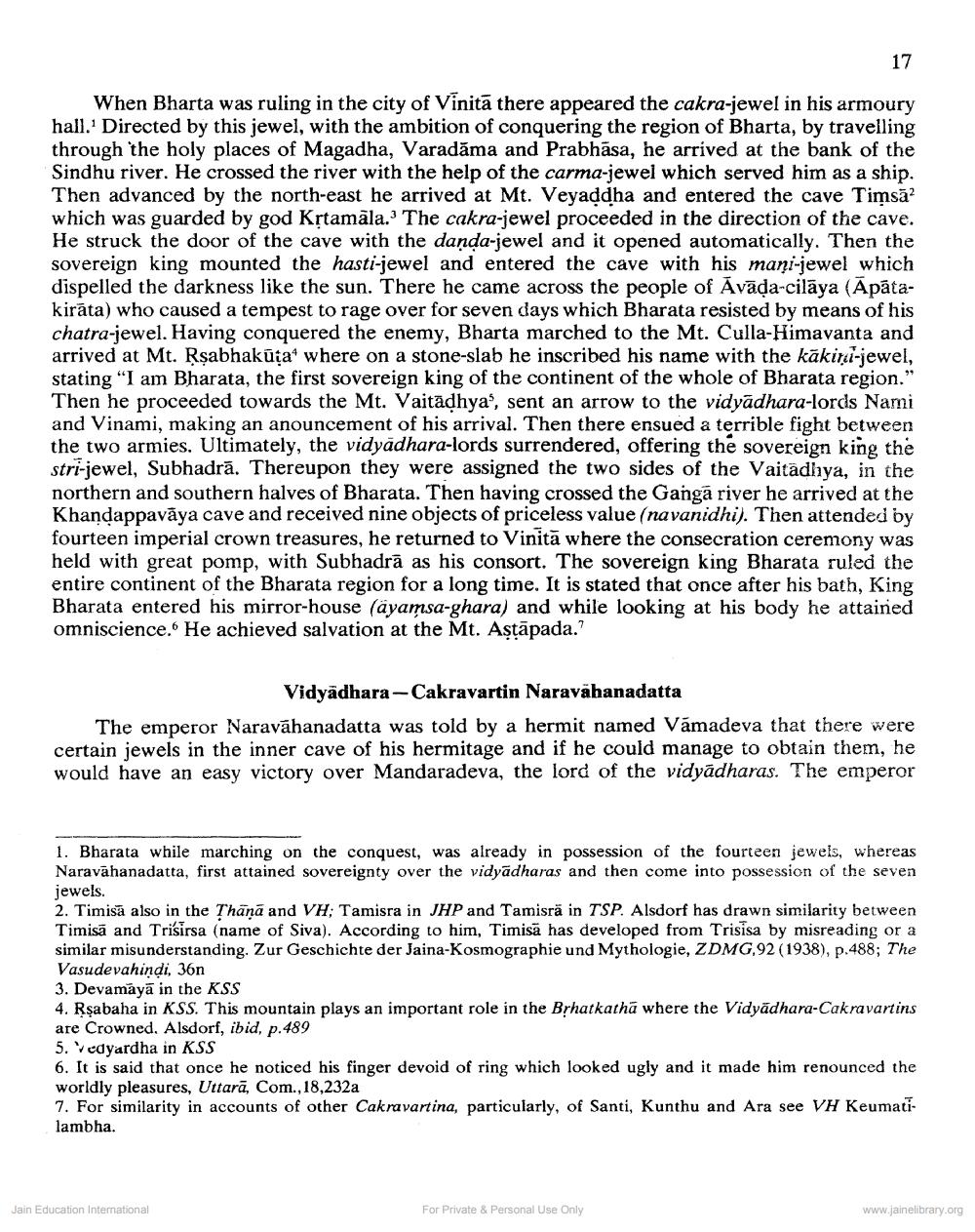________________
When Bharta was ruling in the city of Vinita there appeared the cakra-jewel in his armoury hall.' Directed by this jewel, with the ambition of conquering the region of Bharta, by travelling through the holy places of Magadha, Varadāma and Prabhasa, he arrived at the bank of the Sindhu river. He crossed the river with the help of the carma-jewel which served him as a ship. Then advanced by the north-east he arrived at Mt. Veyaddha and entered the cave Timsă? which was guarded by god Kṛtamāla.' The cakra-jewel proceeded in the direction of the cave. He struck the door of the cave with the danda-jewel and it opened automatically. Then the sovereign king mounted the hasti-jewel and entered the cave with his mani-jewel which dispelled the darkness like the sun. There he came across the people of Avada-cilāya (Apătakirata) who caused a tempest to rage over for seven days which Bharata resisted by means of his chatra-jewel. Having conquered the enemy, Bharta marched to the Mt. Culla-Himavanta and arrived at Mt. Rṣabhakūja' where on a stone-slab he inscribed his name with the käkini-jewel, stating "I am Bharata, the first sovereign king of the continent of the whole of Bharata region." Then he proceeded towards the Mt. Vaitadhya', sent an arrow to the vidyadhara-lords Nami and Vinami, making an anouncement of his arrival. Then there ensued a terrible fight between the two armies. Ultimately, the vidyadhara-lords surrendered, offering the sovereign king the stri-jewel, Subhadra. Thereupon they were assigned the two sides of the Vaitadhya, in the northern and southern halves of Bharata. Then having crossed the Ganga river he arrived at the Khandappavāya cave and received nine objects of priceless value (navanidhi). Then attended by fourteen imperial crown treasures, he returned to Vinita where the consecration ceremony was held with great pomp, with Subhadra as his consort. The sovereign king Bharata ruled the entire continent of the Bharata region for a long time. It is stated that once after his bath, King Bharata entered his mirror-house (ayamsa-ghara) and while looking at his body he attained omniscience. He achieved salvation at the Mt. Aṣṭāpada."
17
Vidyadhara-Cakravartin Naravahanadatta
The emperor Naravahanadatta was told by a hermit named Vamadeva that there were certain jewels in the inner cave of his hermitage and if he could manage to obtain them, he would have an easy victory over Mandaradeva, the lord of the vidyadharas. The emperor
1. Bharata while marching on the conquest, was already in possession of the fourteen jewels, whereas Naravahanadatta, first attained sovereignty over the vidyadharas and then come into possession of the seven jewels.
2. Timisă also in the Thana and VH; Tamisra in JHP and Tamisrä in TSP. Alsdorf has drawn similarity between Timisa and Trisirsa (name of Siva). According to him, Timisa has developed from Trisisa by misreading or a similar misunderstanding. Zur Geschichte der Jaina-Kosmographie und Mythologie, ZDMG,92 (1938), p.488; The Vasudevahindi, 36n
3. Devamaya in the KSS
4. Rṣabaha in KSS. This mountain plays an important role in the Bṛhatkatha where the Vidyadhara-Cakravartins are Crowned. Alsdorf, ibid, p.489
5.
edyardha in KSS
6. It is said that once he noticed his finger devoid of ring which looked ugly and it made him renounced the worldly pleasures, Uttara, Com., 18,232a
7. For similarity in accounts of other Cakravartina, particularly, of Santi, Kunthu and Ara see VH Keumati lambha.
Jain Education International
For Private & Personal Use Only
www.jainelibrary.org




